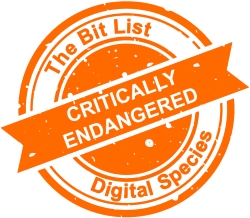Non-current Portable Optical Media
 |
||
|
Materials saved to DVDs, CDs or other optical storage devices where the media is out of warranty and reader devices may no longer be supported or integrated easily into hardware infrastructure: typically, more than five years old. |
||
|
Digital Species: Portable Media |
Trend in 2023:
|
Consensus Decision |
|
Added to List: 2019 |
Trend in 2024:
|
Previously: Critically Endangered |
|
Imminence of Action Action is recommended within three years, detailed assessment within one year. |
Significance of Loss The loss of tools, data or services within this group would impact on people and sectors around the world. |
Effort to Preserve | Inevitability It would require a major effort to prevent or reduce losses in this group, possibly requiring the development of new preservation tools or techniques. |
|
Examples CDs, laserdisc technologies, DVD, HDVD, MiniDisc, Superdisk. |
||
|
‘Practically Extinct’ in the Presence of Aggravating Conditions Poor storage; inability to access readers; no replication; encryption; uncertainty over IPR or the presence of orphaned works. |
||
|
‘Endangered’ in the Presence of Good Practice Active management; dependable access to readers; strong documentation; documentation independent from the media. |
||
|
2023 Review This entry was added in 2019 to ensure that the range of media storage is properly assessed and presented. The 2019 Jury noted optical media is, in some senses, a preferred option as it is typically more stable than magnetic or solid state media, but these characteristics have been oversold. The substrates of the disks can prove unstable, and more importantly, the reader technology tends to be proprietary and can become obsolete long before the disks degrade. Storage at scale also means the percentage likelihood of failure increases. The 2021 Jury and 2022 Taskforce agreed with the entry’s assigned risk classification with no noted changes towards increased or reduced risk. The 2023 Council agreed with the risk classification of Critically Endangered with the overall risks remaining on the same basis as before (‘No change’ to trend). |
||
|
2024 Interim Review The 2024 Council agreed These risks remain on the same basis as before, with no significant trend towards even greater or reduced risk (‘No change’ to trend). |
||
|
Additional Comments We know what to do; it is the scale of the problem. It is a big scale problem - and in many library catalogues the information about these carriers and their playing requirements do not exist in metadata. Big scale surveys of collections to identify these carriers might be a barrier to starting to tackle this one. Optical media is less and less recoverable as time goes on. The data cannot be actively managed, the readers are starting to go out of style, and the carriers will continue to rapidly degrade. Early generations of this media are not as robust as the current generation and can deteriorate significantly if not stored appropriately. Many optical media that were created by individuals using consumer-grade hardware and software are more vulnerable than media created using commercial-grade production techniques, and often user error makes the data unreadable before bitrot and other degradation is able to begin. The presence of adhesive labels can be a big warning sign of this type of vulnerability. Case Studies or Examples:
See also:
|
||





































































































































